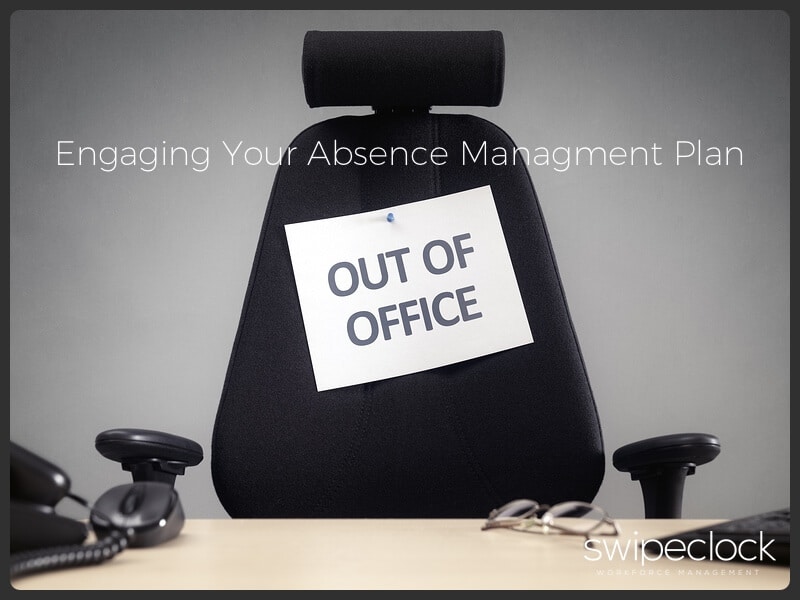How Absence Management Can Help You Build a More Engaged Workforce

What is Employee Absence Management?
Employee absence management is the process of managing employee time off. There are many reasons why employees take time off. Planning for the various kinds of employee absence can improve efficiency and profitability. More companies than ever before are incorporating absence management planning in 2020.
Absence management centers on protocols for dealing with employee sick leave. There are many kinds of sickness absence to consider. Most employees will take occasional days off to take care of a seasonal sickness. Some employees will schedule the time to recover from a planned surgery or medical event. Childbirth or knee surgery are good examples of planned absences.
In extreme cases, employees may develop a chronic pattern of absence. In any case, a sickness management plan will help you identify where problems exist. Proactive employee leave practices will ensure you are following up and correcting problems.
Why is Absence Management Important?
Companies that have a protocol in place are twice as likely to achieve desired outcomes. Companies who don’t have an absence management plan are losing an average of $775 per employee, per year. Improving employee engagement is key to your success.
Guardian Insurance released a study that shows growing interest in absence management. 63 percent of employers report having moderate or advanced systems in place. 37 percent of participating employers reported having little or no system in place.
There is plenty to learn for every company. Whether you’re on the leading edge, or in the beginning stages. Absence management is becoming critical to obtaining good return-to-work outcomes. It also improves employee engagement, reduces sick days, and saves money in lost productivity.
Absence Management Saves Money
Employee absences cost money. There is little debate over the cost of lost time. The average employee is absent for seven days per year. Minor illnesses are the primary cause of short-term absence. In a workgroup of 15 employees, a company will lose 105 days of productivity.
Yet, employee time off isn’t the only problem to worry about.
Effective Absence Management Protects Against Losses in Productivity
Lost productivity due to workforce disruption is an area that is rarely measured. When employees cover for an absent co-worker, extra effort results in lower efficiency. Employee engagement suffers when there is too much to cover.
Employees covering empty gaps in production get tired faster and lose momentum earlier. If the absence continues for more than a couple days, workgroup fatigue becomes an issue.
Effective employee leave practices help mitigate workgroup disruptions. Setting employee expectations before and after an absence will help workgroup recovery. It is important to include all employees in an absence communication plan.
When an employee returns to work, catching up can have the same impact as onboarding. Ramping up to new adjustments can cause slowdowns and opens the door to errors and accidents. Returning employees need an orientation.
A good employee absence plan will help set employee expectations. Communicating with absent and present employees is critical. Employees who understand expectations are more likely to align with company objectives.
Other problems include lawsuits and fines for non-compliance with regulations. An effective employee absence plan will guard against legal and financial setbacks.
Three Key Areas Where SwipeClock Can Help
SwipeClock solutions allow you to create and install an effective absence management plan. TimeWorksPlus and TimeSimplicity provide tools to collect and measure absence data. Managers can use this data to improve absence plans and refine communication protocols.
SwipeClock offers tools to build an effective absence management plan. Let’s look at three ways SwipeClock can help you build a more engaged workforce…
Measure
WorkforceHub time and attendance solution TimeWorksPlus allows you to track employee attendance. Measuring employee attendance is the first step in gathering important data.
Without time and attendance data from your employees, you will not have a basis for a plan. Accurate data is critical, and without an automated system, you risk working with bad data.
TimeWorksPlus provides automated time and attendance data collection. Data you collect in TimeWorksPlus is accurate and timely. You can gather and input data from computers, access cards, and facial and finger scanning time clocks. You can even collect data from mobile devices and remote time clocks.
Your data will be accurate, centralized, and accessible. TimeWorksPlus allows you to collect and measure data in real time, from a central admin.
Measuring allows you to track employee engagement. With measured data, you have the ability to approach employees with facts. Facts remove the emotional clutter that can make attendance discussions seem confrontational.
Analyze
Once you have your data, you are ready to analyze. This is the foundation of your plan; without an analysis of data, you are only guessing.
SwipeClock time and attendance software allows you to view insightful reports. There are even options to export data for external comparison in a spreadsheet. Reports give you an overview of absence trends, troublesome employees, and seasonal swings.
You can use collected data to compare with other organizations. Comparisons highlight trouble spots and show productivity gaps. You can also compare to industry benchmarks. Comparisons allow you to better analyze your workforce condition. You can then plan to make effective changes and better prepare for unplanned absences.
Plan
Using WorkforceHUB Human Resources Management System (HRMS) can help you better understand the causes of absence. Collecting and analyzing data will give you a basis for effective planning.
Build a plan with company policy as the leading framework. Incorporate alerts and triggers to establish consistent response protocols. Place positive employee behaviors as the primary goal. Establish fair and rewarding rules that apply to all employees. Plan to communicate to every employee on a regular schedule to ensure engagement.
Positive reinforcement of wanted behaviors should be the foundation of your plan. Prepare plans to present expectations, address negative behaviors, and respond with established policy.
Chronic absence problems and negative departmental cultures need planned responses. Employee communications are more effective when you have accurate data to present. SwipeClock time and attendance offers a systemic basis for addressing these needs. Accurate time and attendance data allow you to address negative trends. Using facts, and following a plan, will help you avoid legal pitfalls.
Absence Management Best Practices
Along with your SwipeClock software solution, it’s important to include best practices. Your plan should include the following items, and remember to refine and add to your plan as you go.
One of the more common best practices is the return to work interview. Return to work interviews are an effective way to reduce absences. Keep in mind, however, that they only address the problem after the fact. They are most effective when used as part of a comprehensive plan.
Return-to-work interviews are best for employees who have been out for longer than a week. Offer new orientation and reset goals and objectives. Use the time to communicate plan policies and establish engagement.
It is important to remember that you are dealing with real people. We all have unavoidable sick days. Many of us are parents who deal with family responsibilities. One of the most important aspects of your plan should be to remember to be compassionate. Compassion will assure your employees that they work for a caring organization. Employees who feel their company cares for them will care for the company.
Employees who care are productive, motivated and engaged. Engaged employees avoid unnecessary absences, and that’s good for business.
Updated December 21, 2021
Simplify HR management today.
Simplify HR management today.
7 Tips to Reduce Workplace Stress
Considering that the average American worker will spend over 90,000 hours at work during their lifetime, it makes sense that employment is a significant aspect of life. Work can feel like a barometer for other aspects of a person’s lifestyle, whether they’re spending a lot of time commuting or handling extra tasks during shifts. But…
Read MoreSmall Business Owner How-To Series: How to Track Employee Time
At WorkforceHub, we focus on the needs of small businesses. Our solution makes it easy to manage the everyday tasks, but we recognize that many of our clients are newcomers to the world of managing employees and ensuring compliance with labor laws and regulations. In order to provide more value and support, we’re launching a…
Read More




